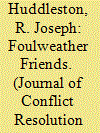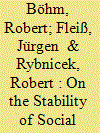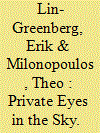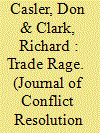|
|
|
Sort Order |
|
|
|
Items / Page
|
|
|
|
|
|
|
| Srl | Item |
| 1 |
ID:
180221


|
|
|
|
|
| Summary/Abstract |
Our study compares the efficacy of mixed bargaining strategies to strict coercion or accommodation. While mixed strategies can be approached from different conceptual angles, we focus on flexible and/or firm postures as signaling properties of bargaining. In our theory and empirical analysis, we show that the combination of firmness with flexibility on both sides, without necessarily scripted rules as in tit-for-tat, leads to peaceful resolution without unilateral concessions. Its opposite, resolute firmness is unlikely to make the opponent yield, as assumed in influential literature of the traditional canon. If anything, war is most likely when both sides opt for it. We provide the theoretical rationale for these expectations, which are validated in our empirical analysis of the ICB crisis dataset for the 1918 to 2015 period. Our study also points to the bargaining process as a potential causal mechanism between democracy and peace, and therefore has relevant implications for several research strands.
|
|
|
|
|
|
|
|
|
|
|
|
|
|
|
|
| 2 |
ID:
180226


|
|
|
|
|
| Summary/Abstract |
This paper investigates how violence in self-determination conflicts influences bilateral foreign policy. I argue that a general preference for international stability causes third parties to support self-determination groups when violence reaches high levels, when they gain territorial control, and when major powers officially recognize. In these conditions, third parties perceive a stable new status quo to be nigh: unrecognized statehood. Ongoing instability encourages foreign policy that encourages the development of the de facto state, even when third parties have no intention of recognizing them as states. Importantly, I also show that targeting civilians erodes third-party support of the perpetrating side. I demonstrate these relationships using a latent variable model of international sovereignty of aspiring states, built on bilateral military, diplomatic, and economic exchange data. My model and tests provide new insight into how aspiring state actors become increasingly eligible for recognition through the tacit support of third-party states.
|
|
|
|
|
|
|
|
|
|
|
|
|
|
|
|
| 3 |
ID:
180227


|
|
|
|
|
| Summary/Abstract |
Despite the omnipresence of inter-group conflicts, little is known about the heterogeneity and stability of individuals’ social preferences toward in-group and out-group members. To identify the prevalence and stability of social preferences in inter-group conflict, we gather quota-representative, incentivized data from a lab-in-the-field study during the heated 2016 Austrian presidential election. We assess social preferences toward in-group and out-group members one week before, one week after, and three months after the election. We find considerable heterogeneity in individuals’ group-(in)dependent social preferences. Utilizing various econometric strategies, we find largely stable social preferences over the course of conflict. Yet, there is some indication of variation, particularly when the conflict becomes less salient. Variation is larger in social preferences toward in-group members and among specific preference types. We discuss the theoretical implications of our findings and outline potential avenues for future research.
|
|
|
|
|
|
|
|
|
|
|
|
|
|
|
|
| 4 |
ID:
180222


|
|
|
|
|
| Summary/Abstract |
How do emerging technologies that erode governments’ near-monopolies on intelligence information affect public support for leaders and their foreign policies? Technologies—like imagery satellites—that were once the domain of state governments are now increasingly available to commercial and private actors. As a result, non-government entities can now exercise the disclosure decision, publicly divulging information whose release was once controlled by states. We argue that non-government entities with access to these technologies serve as alternative information sources that can verify government claims or reveal activities governments have not previously acknowledged. Using original survey experiments we find that commercial satellite imagery can serve as an informational cue that shifts public opinion, and, depending on its content, either attenuates or bolsters the effect of similar cues from government sources. The findings advance debates over secrecy in international relations and on the effect of emerging technologies in the security domain.
|
|
|
|
|
|
|
|
|
|
|
|
|
|
|
|
| 5 |
ID:
180223


|
|
|
|
|
| Summary/Abstract |
Politicians frequently issue public threats to manipulate tariffs but only sometimes follow through. This behavior theoretically ought to generate audience costs. We therefore test the validity of audience costs in trade war settings through a vignette-based survey experiment. The vignettes describe a hypothetical situation involving the U.S. and a second country (China, Canada, or unspecified) with whom the U.S. has a trade deficit. The president (Democrat, Republican, or unspecified) either maintains the status quo, threatens to impose tariffs and backs down, or threatens to impose tariffs and follows through. Our findings highlight differences between security and trade conflict when it comes to audience costs and presidential approval. While Americans sanction the president for issuing a threat to raise tariffs, they generally support backing down. Regression modeling and text analysis of a free response question from our surveys suggest this is because consumers are wary of paying the costs of tariffs.
|
|
|
|
|
|
|
|
|
|
|
|
|
|
|
|
| 6 |
ID:
180224


|
|
|
|
|
| Summary/Abstract |
Governments build walls to curtail a range of illicit activities like immigration, crime, and terrorism. We argue that while physical barriers effectively prevent specific unwanted behavior, they induce actors to respond strategically and develop new tactics, changing the nature of illicit activity and leading to new threats. We test this argument in the context of Israel’s security barrier. Using an instrumental variable unrelated to the underlying threat of attack, we analyze short-term changes in the barrier’s porousness. Terror attacks in Israel are less likely when the barrier is more secure. However, we also observe evidence of changing strategies. Attacks are most likely immediately after the government eases temporary restrictions on movement, suggesting that previously-planned attacks were delayed, not prevented. Furthermore, when the barrier is more secure, terrorists select weapons that are less affected by it and carry out attacks in systematically different locations. Ultimately, walls’ impacts on any challenge depend not just on how well they prevent movement but also on illicit actors’ strategic responses.
|
|
|
|
|
|
|
|
|
|
|
|
|
|
|
|
| 7 |
ID:
180225


|
|
|
|
|
| Summary/Abstract |
To meet the rising demand for minerals, mining companies have ventured into fragile areas, often at the expense of artisanal miners. This has led to grievances, and at times violence. Who among the aggrieved intend to use violence? How can peace be maintained? This paper uses individual-level data to address these questions. Among a sample of 469 about-to-be-evicted artisanal miners in Eastern Congo, we inquire about the intention to engage in several forms of violence. We identify how this intention varies with miners’ past exposure to violence and attitudes towards policies that seek social peace. A large proportion of miners intends to destroy the company’s property, attack its employees, use fire arms, or join an armed group. These would-be-fighters are motivated by grievances, as well as material and social incentives. Our results contribute to understanding the micro-motivations underpinning the local resource curse and entail concrete lessons for mining policies.
|
|
|
|
|
|
|
|
|
|
|
|
|
|
|
|
|
|
|
|
|